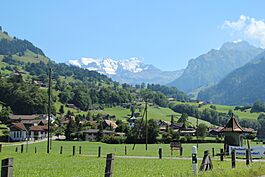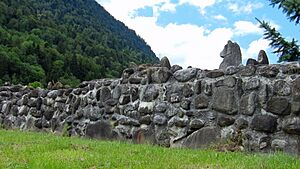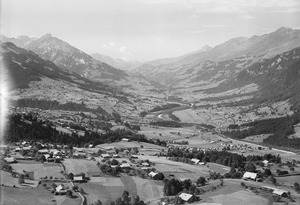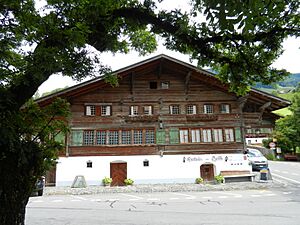Reichenbach im Kandertal facts for kids
Quick facts for kids
Reichenbach im Kandertal
|
||
|---|---|---|

Reichenbach im Kandertal village
|
||
|
||
| Country | Switzerland | |
| Canton | Bern | |
| District | Frutigen-Niedersimmental | |
| Area | ||
| • Total | 125.77 km2 (48.56 sq mi) | |
| Elevation | 700 m (2,300 ft) | |
| Population
(Dec 2020 )
|
||
| • Total | 3,638 | |
| • Density | 28.926/km2 (74.918/sq mi) | |
| Postal code |
3713
|
|
| Localities | Griesalp, Kiental, Reichenbach | |
| Surrounded by | Aeschi bei Spiez, Diemtigen, Frutigen, Kandergrund, Kandersteg, Lauterbrunnen, Wimmis | |
Reichenbach im Kandertal is a village and a local government area (called a municipality) in the canton of Bern in Switzerland. Its name means "Reichenbach in the Kander valley." Before 1957, it was known as Reichenbach bei Frutigen.
This municipality includes the main village of Reichenbach, plus many other smaller settlements. Some of these are Aris, Faltsche, Griesalp, Kien, Kiental, Ramslauenen, Reudlen, Scharnachtal, Schwandi, and Wengi. The village of Mülenen is also partly in Reichenbach.
An important historical event happened here in 1916. The Kienthal Conference was held in Kiental. This meeting was a follow-up to another conference and helped shape a worldwide movement against World War I.
The official symbol (coat of arms) of Reichenbach im Kandertal shows a bear's paw coming out of three green hills.
Contents
A Look at Reichenbach's Past
Reichenbach im Kandertal was first mentioned around the year 1320. In the Middle Ages, this village was in a very important spot. It was on a main trade route that led into the Canton of Valais.
To protect this important road, two castles were built nearby. These were Mülenen Castle, which had a strong wall called the Letzi Mülenen wall, and Aris ob Kien Castle. There might have been a third castle, Faltschen Castle, but we don't know for sure if it was from the Middle Ages.
Reichenbach was once part of a territory called the Herrschaft of Mülenen. In 1352, the city of Bern took control of this territory, and Reichenbach became part of Bern.
Changes in Religion and Local Life
Originally, Reichenbach was part of the church area of Aeschi bei Spiez. In the 15th century, a chapel (a small church) dedicated to St. Nicholas was built in Reichenbach. It was first mentioned in 1453 and rebuilt in 1484. Over the years, it was updated and made bigger.
When Bern adopted the Protestant Reformation in 1529, Reichenbach also changed its faith. It then got its own church area (parish). Later, in 1929, a smaller church was built in Kiental. However, the villages of Wengi and Schwandi are still part of the Frutigen church area.
For a long time, people in Reichenbach mostly earned a living from farming. They also practiced seasonal alpine herding, which means moving animals to different pastures depending on the season. Some trade happened over the mountain passes too. Starting in the 16th century, local farmers began raising cattle to sell to other places. In 1865, a factory that made matchsticks opened in the area.
Modern Connections and Tourism
Transportation improved a lot over time. In 1814, a post carriage service started between Reichenbach and Thun. Then, in 1901, a railway line was built that connected the municipality to Spiez. More railways followed: the Niesen train in 1910 and the Bern-Lötschberg-Simplon Railway in 1913.
These new transport links quickly made Reichenbach a popular place for tourists. More people moved to the area, and many vacation homes were built. A military airport was built in the valley, but it became a civilian airport in 1994. A secondary school was built for students in 1959–60.
The Kienthal Conference
The Kienthal Conference took place in Kiental from April 24 to 30, 1916. This meeting was very important. It continued the work of an earlier conference that aimed to create an international movement against World War I. The ideas from the Kienthal Conference helped to bring together groups that later formed the Communist Third International.
On December 31, 2009, the old administrative district of Frutigen was closed. The next day, January 1, 2010, Reichenbach joined the new Frutigen-Niedersimmental administrative district.
Exploring Reichenbach's Geography
The village of Reichenbach im Kandertal sits in the valley of the Kander river. The municipality includes about 4.5 kilometers (2.8 miles) of this valley and the hillsides around it.
However, the municipality also stretches far up the valley of the Chiene river. This part is about 16.5 kilometers (10.3 miles) long, going from where the Chiene river meets the Kander river all the way to its source near the Schilthorn and the Blüemlisalp mountains.
From the upper Chiene valley, there are rough paths that cross two mountain passes: the Sefinafurgga and the Hohtürli. These paths lead towards Lauterbrunnen and Kandersteg. They are part of the Alpine Pass Route, which is a long hiking trail across Switzerland.
Many of the settlements in Reichenbach are in or on the slopes of the Kander valley. These include Aris, Faltsche, Mülenen, Reichenbach, Reudlen, Schwandi, and Wengi. Other settlements like Griesalp, Kien, Kiental, Ramslauenen, and Scharnachtal are located in the Chiene valley.
The municipality also includes parts of several mountain peaks. Some of these are the Ärmighorn, Bütlasse, Drättehorn, Dreispitz, Drunengalm, Dündenhorn, Fromberghorn, Gspaltenhorn, Hundshorn, Morgenhorn, Niesen, Schwalmere, Wätterlatte, and Wildi Frau.
Land Use in Reichenbach
Reichenbach im Kandertal covers an area of about 125.8 square kilometers (48.6 square miles).
- About 39.3% of this land is used for farming.
- About 24.5% is covered by forests.
- About 2.3% has buildings or roads.
- About 1.1% is rivers or lakes.
- The remaining 32.8% is unproductive land, meaning it's not used for farming or building. This includes rocky areas and glaciers.
Who Lives in Reichenbach?
Reichenbach im Kandertal has a population of about 3,500 people. As of 2010, a small part of the population (3.9%) were foreign nationals. Between 2000 and 2010, the population grew by about 6.3%.
Most people in Reichenbach (about 97.1%) speak German as their main language. Albanian is the second most common language, and French is the third.
In 2008, the population was almost evenly split between males (49.1%) and females (50.9%). About half of the people living in Reichenbach in 2000 were born there. Many others were born in the same canton (Bern), while some came from other parts of Switzerland or from other countries.
In 2010, young people (ages 0–19) made up 22.2% of the population. Adults (ages 20–64) made up 58.1%, and seniors (over 64) made up 19.7%.
The number of people living in Reichenbach has changed over time, as shown in this chart:

Fun Things to See and Do
Reichenbach im Kandertal offers some exciting attractions, especially for those who love nature and outdoor activities.
The Niesenbahn Funicular
Since 1910, you can ride a special mountain railway called the Niesenbahn up the nearby Niesen mountain. This mountain is 2,362 meters (7,749 feet) high. The Niesenbahn is very steep, with slopes up to 68%! At 3,499 meters (11,480 feet) long, it is the longest funicular railway in Europe. A funicular is a type of cable railway that uses two cars connected by a cable, moving up and down a steep slope.
Adventures in Kiental Valley
In summer, the Griesalp and Kiental valley area is famous for its mountain hikes and high-altitude treks. There are about 250 kilometers (155 miles) of hiking trails to explore. You can see beautiful flower meadows, forests, clear streams, and waterfalls.
When winter arrives, this same area turns into a popular skiing spot. The upper part of the Kiental valley is part of the Jungfrau-Aletsch World Heritage Site. This means it's a very special natural area protected by UNESCO.
Important Historical Buildings
Several places in Reichenbach im Kandertal are listed as important Swiss heritage sites. These include the Gasthof Bären (an old inn), the Letzi Mülenen (a medieval fortified wall), and the Notar-Sieber-House.
The Letzi Mülenen was a castle and wall built in the 12th and 13th centuries. It was built by a noble family to control who could pass through the alpine route into the Canton of Valais. Over time, it changed owners and eventually was sold to Bern in 1352. Under Bernese rule, a castellan (a castle governor) lived there. However, around 1400, the castellan moved, and the castle was left. Its stones were later used to build other things.
How People Make a Living
In 2011, Reichenbach im Kandertal had a very low unemployment rate of 0.75%. This means most people who wanted to work had jobs.
In 2008, there were 1,290 people working in the municipality.
- About 361 people worked in the primary sector, mostly in farming.
- About 421 people worked in the secondary sector, which includes manufacturing and construction.
- About 508 people worked in the tertiary sector, which covers services like sales, transportation, hotels, restaurants, education, and healthcare.
Many people who live in Reichenbach im Kandertal travel to other places for work. In 2000, 877 people commuted out of the municipality for their jobs, while 321 people commuted in. Most people (57.6%) used a private car to get to work, while 12.9% used public transportation.
Getting Around Reichenbach
Reichenbach im Kandertal has good transport links.
Train Travel
The municipality has two train stations: Reichenbach im Kandertal station and Mülenen station. Both are on the Lötschberg line. You can catch hourly trains called Lötschberger that go to Bern, Thun, Spiez, and Brig.
Bus Services
PostAuto buses also serve the municipality. You can take a bus from Reichenbach train station up the Kander river valley to Reudlen, Wengi, and Frutigen. There's also a bus service up the Chiene river valley to Scharnachtal, Kiental, and Griesalp. The bus service to Griesalp is known as the steepest post bus service in Europe!
Mountain Lifts
Besides the Niesenbahn funicular from Mülenen station to the top of the Niesen, there is also a chair lift that connects Kiental with Ramslauenen.
Faith and Community
In 2000, most people in Reichenbach im Kandertal (about 81.5%) belonged to the Swiss Reformed Church (a Protestant church). About 3.9% were Roman Catholic. A smaller number of people belonged to other Christian churches, or to other religions like Islam. About 3.5% of the population did not belong to any church.
Learning and Education
Education is important in Reichenbach im Kandertal. About 38.8% of the population has completed non-mandatory upper secondary education. This means they went to school beyond the basic required years. Also, 6.3% have completed higher education, like university or a specialized college.
The school system in the Canton of Bern starts with one year of optional Kindergarten. After that, children attend six years of Primary school. Then, they go to three years of compulsory lower Secondary school. In secondary school, students are grouped based on their abilities. After lower Secondary school, students can choose to continue their education or start an apprenticeship (on-the-job training).
In the 2010–11 school year, Reichenbach im Kandertal had 382 students.
- There were 4 kindergarten classes with 62 students.
- There were 12 primary classes with 211 students.
- There were 6 lower secondary classes with 109 students.
Reichenbach im Kandertal also has a local library called Dorfbibliothek Reichenbach. In 2008, the library had almost 8,000 books and other media. It loaned out over 13,800 items that year.
Images for kids
See also
 In Spanish: Reichenbach im Kandertal para niños
In Spanish: Reichenbach im Kandertal para niños












